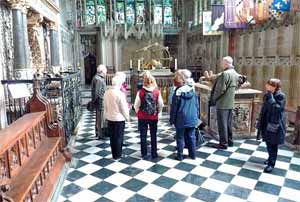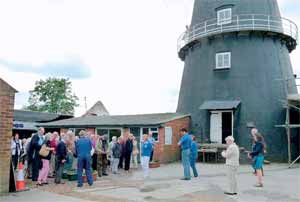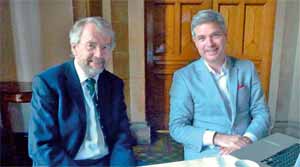Events and excursions, Summer 2015
SAINT MARY’S COLLEGIATE CHURCH, WARWICK, AND BADDESLEY CLINTON 19TH MAY 2015
LEADER: ALAN LANGTON

St Mary's church, Warwick.
Members on the coach approaching Warwick saw the imposing tower of Saint Mary’s Church long before we arrived in the town. The present church building is not ancient, although the crypt contains the massive pillars of the original 12th century building of Roger Newburgh, Earl of Warwick. At this time it was a non-monastic collegiate church, with a dean and seven canons. When the earldom passed to the Beauchamp family, the church building was erected by 1394, complete with the famous Beauchamp chapel (currently being restored), and the amazing flying ribs of the chancel roof. A massive fire destroyed much of Warwick town centre in 1694, and only the chancel of the church was saved. Queen Anne contributed a fifth of the cost of rebuilding the church. The architectural style of the west end of the church was thus changed, and the huge tower was added. We had four very pleasant and helpful guides who took us round the church, the chapels, the crypt, the chancel with its gilded effigy of Richard Beauchamp, and the tomb of Robert Dudley, Earl of Leicester. It was good to be able to see inside a building which is such a striking vision from the road systems around Warwick.
After free time for lunch we travelled the short distance to Baddesley Clinton, originally a moated medieval hall turned into a fine Tudor residence. The home of the Ferrers family for twelve generations, it was used as a secret Roman Catholic centre, complete with priests’ hiding holes after the Reformation. It was taken over by the National Trust in 1980, but still retains rooms and relics of mystery and imagination. Members were able to wander freely in the house and the garden, with knowledgeable guides placed in most areas to answer questions. We completed our tour with tea in the restaurant. The day was enjoyable, and we managed to avoid the occasional downpours with precision timing of being inside when heavy showers struck.
Alan Langton
LOUTH AND HECKINGTON 18TH JUNE 2015
LEADER: ALAN LANGTON

At the windmill in Heckington, with members of the party waiting to go up the mill.
This was one of the better supported excursions that we have had for some time; perhaps it was the journey into Lincolnshire that was the attraction. Our first stop was the old market town of Louth, where we were greeted with coffee and delicious home-made cake by the ladies of Saint James’ church which dates from around 1200 A.D. The 295 foot high spire is a most impressive landmark which can be seen from miles around. Our tour of the church was led by Mr Stuart Sizer. We were over-awed by the beauty of the Georgian roof with its angels and bosses, and Stuart pointed out the sunburst emblem of Edward IV on the inside ceiling of the tower, 86 feet above the floor. The church boasts some fine old chests, the oldest complete with multiple locks. The chests, or ‘hutches’, were used for storing valuables such as vestments and documents. One, the Sudbury Hutch, was presented to the church by Thomas Sudbury in 1503. The doors hold reliefs of Henry VII and Elizabeth of York, with a Tudor rose surmounted by a crown between them.
The church’s treasures include some fine pews (the ‘Corporation’ pews) carved by craftsman and local borough engineer, Mr T.W. Wallis (1821-1903). The armrests of these pews are decorated with animal
carvings. Mr Wallis also carved the woodwork of the unusual pulpit. He included the eleven disciples, with Judas appearing just as a face looking out of foliage.
The church spire has had a chequered history. Repairs had to be made in 1632 after a great storm which nearly brought it down. The spire was struck by lightning in 1844 and during the repairs the height was increased to 295 feet. Further refurbishments took place, and a complete restoration was made in 1868-9, resulting in the church that we see today.
I feel we agreed with the guide that visitors are drawn to the church by its aura of spirituality and architectural beauty. After lunch we moved to Heckington windmill, the only eight sailed mill in the country, where the agility of members was tested by the need to climb steps and stairs inside the building. The most welcoming and helpful staff here gave detailed explanations of the working of the mill from the arrival of the new grain to the fine flour it produces. Each floor of the mill as we ascended or descended demonstrated the clever process by which the turning of the sails produced such excellent results. [The flour we bought makes wonderful bread – Ed]
Several members of the party paid a visit to the micro-brewery situated next door to the windmill, and which sold a range of craft ales and ciders. They returned to the coach carrying heavy bags containing bottles!
We then moved across the town to Saint Andrew’s Church. Here we had a scholarly guided tour and presentation by Mr Michael Rose of the history and development of this fine building which possesses outstanding windows, an Easter sepulchre in remarkable condition, and a wealth of carvings. There are also three mass dials, one on a south-facing buttress and two on opposite sides of the porch. Another team of very competent ladies produced a most enjoyable tea for us. We agreed that the policy at Louth and at Heckington to make the pleasure of visiting these churches more widely known across the country is indeed worth supporting.
Alan Langton
2015 SPECIAL LECTURE – THURSDAY 9TH JULY
Dr Jonathan Foyle - ‘Lincoln Cathedral: the Biography of a Great Building’

Professor Beckett with Dr Jonathan Foyle.
A crowded room was waiting to welcome Dr Jonathan Foyle as our special lecturer on 9th July in the beautiful surroundings of Kelham Hall. Jonathan’s lecture was entitled “Lincoln Cathedral: the biography of a great building” and proved to be an exceptionably powerful retelling of the creation of this architectural and spiritual masterpiece.
Jonathan, an architectural historian, broadcaster and expert enthusiast for heritage buildings, impressively illustrated his lecture with many photographs, plans and comparative examples. It was a most enjoyable and illuminating lecture which was very well received by the members present. They also showed their enthusiasm for the talk by the long queue to buy the copies of Jonathan’s book on Lincoln Cathedral which he had managed to bring to Newark on the train – he duly signed all the copies and subsequently sent more for those disappointed on the evening. The Lincoln volume is the latest book from Dr Foyle, who has also recently published one on Canterbury Cathedral, with another on Lichfield Cathedral soon to be available.
I was very pleased to be able to meet Jonathan at Newark Station on that evening and, having an hour or so to spare, we took a detour to Southwell and visited the Minster which our visitor admires greatly: he said that “the wonderful late 13th century work at Southwell Minster doesn’t get any better than this”. Maybe a Foyle volume on our Nottinghamshire treasure may appear sometime in the future!
With great generosity Jonathan waived the fee for his lecture and asked that, instead, the Society give an appropriate amount to the Newstead Abbey Restoration Fund – we are pleased to be able to forward £500 to the fund, the proceeds of the evening’s lecture.
Thanks go to Jonathan Foyle for his visit to us in Nottinghamshire, also to Jonathan Pass and his staff at Kelham Hall for allowing us the use of an ideal venue and providing us with post-lecture refreshments.
We will soon be planning our next special lecture – proposed for 2017
Barbara Cast
[We plan to review the book in the next issue – Ed.]